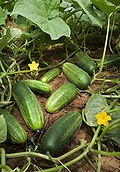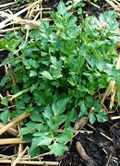Daily Gardening Tips
From eagle-rock.org
- All these tips and more first appeared on this Facebook page.
- List of Daily Gardening Tips gives an alphabetical list of all tips.
June 2012
Day Topic Tip Photo Photo caption More 15 Gherkins Gherkins and commercial cucumbers belong to the same species (Cucumis sativus), but are from different cultivar groups. You sow gherkins in May and June. Sow in a cold frame, in pots or in a greenhouse, or outside from the end of May. Sow 3 seeds together and keep the strongest. Gherkins needs full sun and a humus-rich fertile soil. Plant distance: 40 cm in the row, 90 cm between the rows. 
From Deutschlands Flora in Abbildungen Gherkin 14 Mycorrhiza 'Mycorrhiza' is a new page on the Eagle Rock Wiki site. This is about how fungi help plants to take in many nutrients from the soil. It's only more recently that scientists and farmers became aware of the importance of mycorrhizae. The underground mycelium of fungi, for example ordinary mushrooms, extend the root systems of plants. They can even connect several trees together and these trees, through their 'internet' communicate with each other, help each other in times of drought and scarcity. 
The photo shows a network of hyphae of a fungi that inhabits the roots of flax Mycorrhiza 13 Fava beans Sow fava beans (also called broad beans) in February and March. You can also sow under glass already in late autumn or January. Fava beans can overwinter. Don't add manure to the soil but some old compost is ok, or sawdust to prevent the beans from rotting. Sow some dill in the same row, they protect against blackfly. Another method against blackfly is to pinch out the tops when the plant begins to blossom. You can stir-fry these tops and they are delicious. 
Fava bean 12 Endive Endive is a member of the chicory genus, of which the leaves are often bitter. You can sow them in March under glass and plant them out in May, or sow outside after June 21 for winter harvest. During the first month of growth, endive should not be exposed to temperatures below 50 F (10 C) or the plants will soon make flowers instead of nice green heads. Seeds sown after June 21 won't make flowers anymore. 
Foto source Endive 11 Cucumber The cucumber originates in India but is now grown around the world. Depending on the cultivar you can grow them in a greenhouse, a cold frame or outside. In April you can sow inside, in May until June 21 also outside. Cucumbers like humus-rich soil and ample compost. A temperature of 70 F (21 C) when the plant grows up gives stronger plants and better results. Most varieties have seeds. Male and female flowers grow at the same plant and pollination is required. 
Cucumber 10 Celery The normal celery, of which the leaves are used, is sown in spring in March and later again in September. I usually sow in pots and plant them out later. You can also mix the seeds with moist sand and let them start to germinate before sowing outside. In September you can sow in pots or under glass. You can actually sow through the entire summer, but the plants won't become as big as those sown in March. 
Celery 9 Growing carrots Carrots like any soil but rocks will deform them. They also don't like and don't need compost or manure. I always sow them in a field that was composted the year before and where another crop has grown on that compost. They grow well even in soils that are so poor that most other crops won't develop. Sow summer carrots from February to the end of June. Winter carrots from March to May. Add wet sand to the seeds and keep them a few days like this, then sow the seeds together with the sand. The sand helps you sow regularly and the moist seeds germinate faster. Sow ca 2 cm deep. 
From Deutschlands Flora in Abbildungen Carrot 8 Beetroot You can sow beetroot directly into the soil. It helps to put the seeds a few days in water to make them germinate faster. You can also sow beets in pots and then plant them out, but because beets have taproots you cannot keep them long in pots. Thin the beets at 15 cm in the row. Desired pH = 6-6.5 (a bit acid). Beetroots need to grow in the full sun and don't tolerate shade. Beetroot Beetroot 7 Growing beans Only sow when there's no danger anymore for frost or night frost. For the region where i have my garden (temperate climate, northern hemisphere) this is after May 15. You can sow until half July, depending on the species. Don't add fresh manure to the soil, but beans like a humus-rich soil so you can add some old compost or saw dust to prevent the beans from rotting. Beans like full sun and dislike cold and wet weather. 
Green beans Bean (Phaseolus vulgaris) 6 Watering plants When you water your lawn or your plants, outside or in a greenhouse, it's better to do this infrequently than to sprinkle daily. When you give water daily the plants have the tendency to keep their roots near the surface. But when you occasionally give them a good quantity of water, the plants will send their roots deeper and the entire plants become stronger. 
Sprinkler Watering a garden 5 Integrated garden What is an integrated garden? It is a garden with a variety of different plants, medicinal plants, herbs, flowers, leaf vegetables, root vegetables, berry bushes, etc. Each plant species has its own energy and also receives typical energies from the cosmos and the earth and all that is around. Flowers receive other energies than roots. Plants can mutually enrich one another in the sense of energies. Crops grown in such a garden have better nurturing elements for your spiritual well-being. Sweet William & foxglove, garlic, cabbage, potatoes Spiritual aspects of gardening 4 Preparing the soil Section 4 of the Gardening Seminar:Start your own garden tells about different soil layers, digging a soil and water management. Normal digging with a spade Preparing the soil 3 Mulching In nature healthy soils are covered, either with green plants or with leaf litter. Covered soil has a crumbly texture, allows water to pass through and is a rich environment for many micro-organisms that need oxygen. Soil under a layer of mulch will seldom dry out. In our garden we can copy this natural condition by sowing green manure plants on empty fields, or covering them with a layer of mulch. For mulch we can use hay or straw or also any other natural material. You can also cover the soil with mulch in-between bigger plants, such as berry bushes and larger perennials. 
Leaves make natural mulch Mulching 2 Bees in the garden "Bees play an important role in pollinating flowering plants, and are the major type of pollinator in ecosystems that contain flowering plants. Bees either focus on gathering nectar or on gathering pollen depending on demand, especially in social species. Bees gathering nectar may accomplish pollination, but bees that are deliberately gathering pollen are more efficient pollinators. It is estimated that one third of the human food supply depends on insect pollination, most of which is accomplished by bees, especially the domesticated European honey bee."[1] A swarm of bees Pollination 1 Sowing "Prepare the surface earth well, to make a good seed-bed. Plant when the ground is moist, if possible, and preferably just before a rain... For shallow-planted seeds, firm the earth above them by walking over the row or by patting it down with a hoe [I usually do it with the back side of a rake, or with my hand]. Special care should be exercised not to sow very small and slow-germinating seeds, as celery, carrot, onion, in poorly prepared soil or in ground that bakes. The photo shows little holes made with a board with bumps for sowing radish seeds. I cover them with lava gravel or fine soil. Sowing





